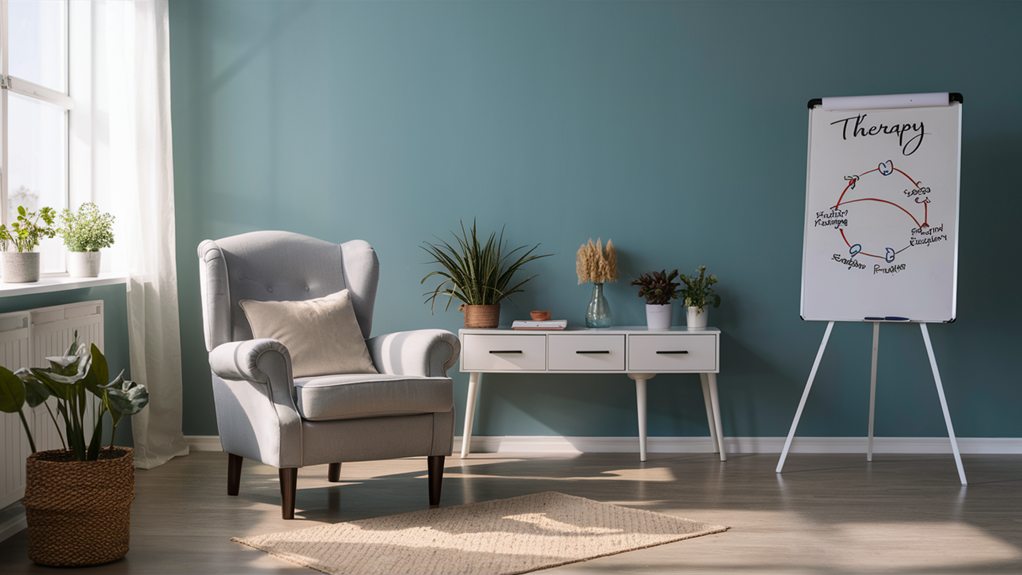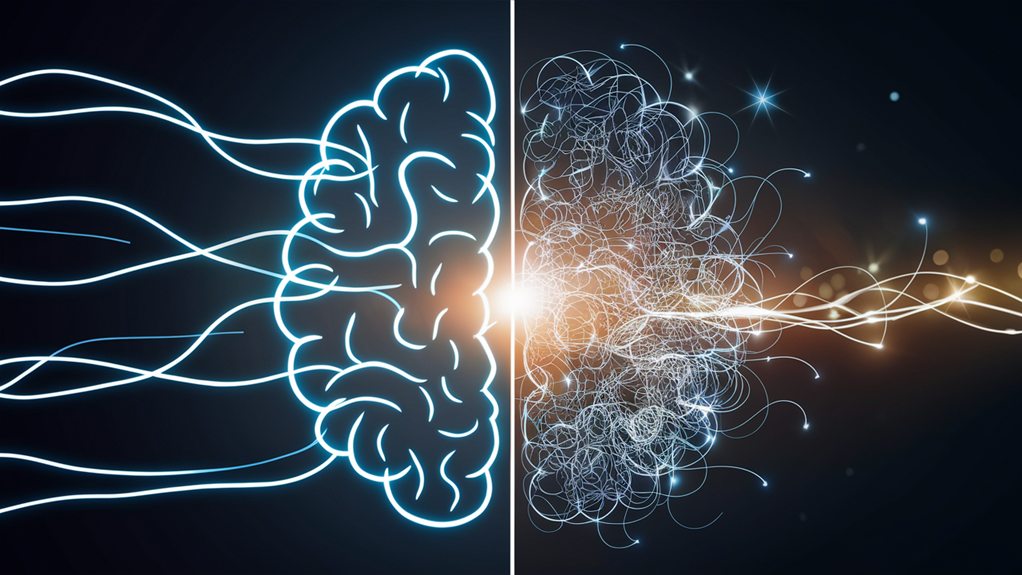Cognitive Behavioral Therapy (CBT) is a powerful treatment that helps you understand how your thoughts affect your feelings and behaviors. When you work with a CBT therapist, you'll learn to identify negative thought patterns and replace them with healthier perspectives through structured exercises and homework assignments. CBT has proven especially effective for conditions like anxiety, depression, PTSD, and eating disorders, with 50-75% of people reporting significant improvement after treatment. Your therapist will guide you through practical techniques, including thought records and exposure therapy, typically over 12-20 sessions. There's much more to discover about this life-changing therapeutic approach.
Understanding CBT Fundamentals

Like a bridge connecting thoughts to actions, Cognitive Behavioral Therapy (CBT) rests on the principle that our thoughts directly influence our feelings and behaviors. When you're seeking CBT for mental health concerns, you'll learn to identify negative thought patterns that might be holding you back from living your best life.
During CBT treatment, you'll work with a therapist to understand how your thoughts create a ripple effect through your emotions and actions. For example, if you're experiencing cognitive behavioral therapy for anxiety, you'll discover how anxious thoughts like "I can't handle this" can trigger physical symptoms and avoidance behaviors.
Your therapist will guide you through practical exercises to challenge these thoughts and develop healthier perspectives.
The beauty of CBT lies in its structured approach, where you'll learn specific tools and techniques to reshape your thinking patterns. You'll master skills like thought recording, reality testing, and behavioral experiments that help you break free from negative cycles.
Think of it as rewiring your mental GPS to find better routes around life's challenges, creating lasting positive change through practice and persistence.
Core Principles of CBT
The building blocks of CBT rest on three fundamental principles that work together to create meaningful change. First, your thoughts directly influence your feelings and behaviors, creating a connected cycle that affects your daily life. This cycle can be particularly pronounced in individuals dealing with understanding depression, where negative thought patterns can exacerbate feelings of hopelessness.
Second, you can learn to identify and challenge unhelpful thinking patterns, which is especially powerful when using CBT for depression. Third, you can develop practical skills to modify your behaviors and create positive changes.
These principles work together like gears in a machine, each one supporting the others to help you make lasting improvements. When you're feeling down, for instance, you'll learn to recognize negative thought patterns, challenge them with evidence, and replace them with more balanced perspectives.
The benefits of CBT become apparent as you practice these skills and apply them to real-life situations. You'll find that CBT's structured approach helps you break down overwhelming problems into manageable pieces.
Benefits and Treatment Applications

CBT's versatile treatment approach offers proven benefits across multiple mental health conditions, from anxiety and depression to eating disorders and post-traumatic stress disorder.
You'll find that CBT can help you develop practical coping strategies, change negative thought patterns, and improve your overall emotional well-being.
When you're working with a CBT therapist, you'll learn to identify and challenge unhelpful thoughts that might be affecting your daily life.
The skills you'll gain aren't just useful during therapy sessions; they'll become valuable tools you can use throughout your life.
You'll discover how to manage stress more effectively, communicate better with others, and solve problems more systematically.
Research shows that CBT can greatly reduce symptoms of various conditions, often working as effectively as medication for some disorders.
You'll typically see improvements within 12 to 20 sessions, though this can vary based on your specific needs.
The techniques you'll learn, such as relaxation exercises, journaling, and gradual exposure to fears, will help you build resilience and maintain long-term mental health improvements.
CBT Therapeutic Techniques
Core therapeutic techniques in CBT focus on identifying, challenging, and modifying problematic thoughts and behaviors. When you're working with a CBT therapist, you'll learn practical strategies that help you recognize negative thought patterns and develop healthier ways of thinking.
Nutrition can also play a role in managing anxiety, as certain foods can exacerbate symptoms while others may help alleviate them foods that impact anxiety. Through structured sessions, you'll discover how your thoughts directly influence your emotions and behaviors, allowing you to make positive changes in your daily life.
- Thought records: You'll keep track of your automatic thoughts, emotions, and situations that trigger them.
- Behavioral activation: You'll gradually increase your engagement in positive activities, even when you don't feel motivated.
- Cognitive restructuring: You'll learn to challenge and replace negative thoughts with more balanced, realistic ones.
- Exposure therapy: You'll face feared situations step by step in a controlled, supportive environment.
Your therapist will guide you through these techniques, helping you practice and master them over time. As you work together, you'll develop skills that you can use independently to manage stress, anxiety, and other challenges.
These evidence-based methods will become valuable tools that you'll continue to use long after your therapy sessions end.
The CBT Session Structure

Structuring each CBT session follows a consistent format that helps maximize therapeutic progress and goal achievement.
When you attend a typical CBT session, you'll start with a brief mood check and review of your previous week, which helps your therapist understand your current state of mind. You'll then discuss any homework assignments you've completed and share your experiences practicing the skills you've learned.
The middle portion of your session focuses on your primary concerns for that day, where you'll work with your therapist to identify problematic thoughts and develop healthier alternatives. During this time, you'll learn and practice specific CBT techniques that address your unique challenges. Your therapist will guide you through exercises, role-playing, or problem-solving activities that help reinforce these new skills.
In the final minutes, you'll summarize what you've learned and set goals for the upcoming week. Your therapist will assign new homework that builds on the session's progress, ensuring you'll have practical exercises to work on between appointments.
This structured approach helps you stay focused and makes the most of your therapy time.
Common Exercises and Homework
As discussed in the session structure, homework plays an essential role in making CBT effective. Between sessions, you'll work on specific exercises that help reinforce what you've learned and build new mental habits. These practice activities let you apply CBT techniques to real-life situations, making the therapy much more meaningful and practical.
Your therapist will typically assign exercises that match your specific challenges and goals. They'll make sure you understand each task and feel confident about completing it on your own.
Common CBT homework assignments include:
- Thought records, where you'll track negative thoughts and practice reframing them into more balanced perspectives
- Behavioral activation tasks, which involve scheduling and completing activities that boost your mood
- Exposure exercises that gradually help you face fears or anxiety-provoking situations
- Relaxation techniques, such as deep breathing or progressive muscle relaxation, which you can practice daily
Remember to keep notes about your experiences with these exercises, including any difficulties or insights you discover. This information will help guide your next therapy session and allow you and your therapist to adjust your treatment plan as needed.
Research and Evidence Base

The evidence supporting CBT's effectiveness spans decades of rigorous research and clinical trials. You'll find thousands of studies showing that CBT works well for many mental health conditions, including depression, anxiety, PTSD, and eating disorders. This is particularly relevant for treating various types of anxiety disorders, such as generalized anxiety disorder and social anxiety disorder.
Scientists have consistently found that CBT helps people feel better and make lasting changes in their lives.
When you look at the research numbers, you'll see impressive results. Studies show that 50-75% of people who complete CBT experience significant improvement in their symptoms.
What's really exciting is that these positive changes often last long after therapy ends, which means you're learning skills that stick with you. Research has also shown that CBT works just as well as medication for many conditions, and when you combine the two, you'll often get even better results.
The strongest evidence comes from randomized controlled trials, where researchers carefully track how people improve with CBT compared to other treatments. These studies have helped make CBT one of the most trusted and recommended forms of therapy you can find today.
Finding a CBT Therapist
Now that you understand CBT's strong scientific backing, finding the right therapist to deliver this treatment becomes your next important step.
You'll want to start by looking for licensed mental health professionals who specifically list CBT as one of their primary treatment approaches. Many therapists offer CBT, but it's important to find someone who's received proper training and maintains current knowledge of CBT techniques.
When searching for a CBT therapist, consider these key factors:
- Check their credentials and verify they're licensed in your state, looking specifically for psychologists, social workers, or counselors with CBT specialization.
- Contact your insurance provider for a list of in-network CBT practitioners, which can help make treatment more affordable.
- Ask about their experience treating your specific concerns, as many therapists focus on particular areas like anxiety or depression.
- Request a brief consultation call to discuss their approach and ascertain you feel comfortable with their communication style.
You can find qualified CBT therapists through professional organizations, online directories, or referrals from your healthcare provider.
Don't hesitate to schedule consultations with multiple therapists before making your final choice.



